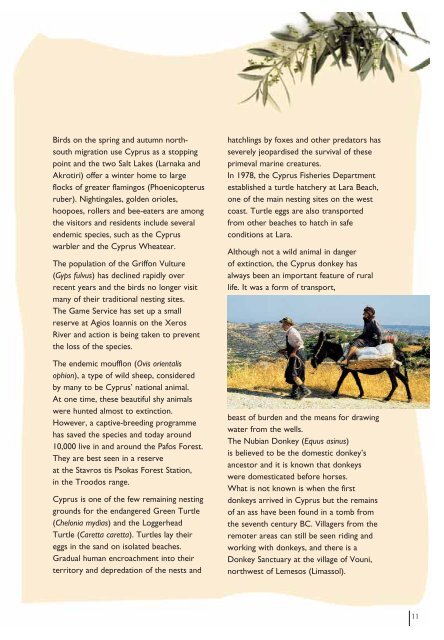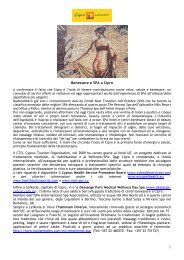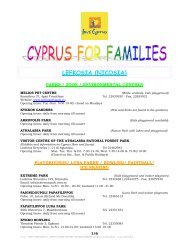Untitled - ente nazionale per il turismo di cipro
Untitled - ente nazionale per il turismo di cipro
Untitled - ente nazionale per il turismo di cipro
You also want an ePaper? Increase the reach of your titles
YUMPU automatically turns print PDFs into web optimized ePapers that Google loves.
Birds on the spring and autumn northsouth<br />
migration use Cyprus as a stopping<br />
point and the two Salt Lakes (Larnaka and<br />
Akrotiri) offer a winter home to large<br />
flocks of greater flamingos (Phoenicopterus<br />
ruber). Nightingales, golden orioles,<br />
hoopoes, rollers and bee-eaters are among<br />
the visitors and residents include several<br />
endemic species, such as the Cyprus<br />
warbler and the Cyprus Wheatear.<br />
The population of the Griffon Vulture<br />
(Gyps fulvus) has declined rapidly over<br />
recent years and the birds no longer visit<br />
many of their tra<strong>di</strong>tional nesting sites.<br />
The Game Service has set up a small<br />
reserve at Agios Ioannis on the Xeros<br />
River and action is being taken to prevent<br />
the loss of the species.<br />
The endemic moufflon (Ovis orientalis<br />
ophion), a type of w<strong>il</strong>d sheep, considered<br />
by many to be Cyprus’ national animal.<br />
At one time, these beautiful shy animals<br />
were hunted almost to extinction.<br />
However, a captive-bree<strong>di</strong>ng programme<br />
has saved the species and today around<br />
10,000 live in and around the Pafos Forest.<br />
They are best seen in a reserve<br />
at the Stavros tis Psokas Forest Station,<br />
in the Troodos range.<br />
Cyprus is one of the few remaining nesting<br />
grounds for the endangered Green Turtle<br />
(Chelonia my<strong>di</strong>as) and the Loggerhead<br />
Turtle (Caretta caretta). Turtles lay their<br />
eggs in the sand on isolated beaches.<br />
Gradual human encroachment into their<br />
territory and depredation of the nests and<br />
hatchlings by foxes and other predators has<br />
severely jeopar<strong>di</strong>sed the survival of these<br />
primeval marine creatures.<br />
In 1978, the Cyprus Fisheries Department<br />
established a turtle hatchery at Lara Beach,<br />
one of the main nesting sites on the west<br />
coast. Turtle eggs are also transported<br />
from other beaches to hatch in safe<br />
con<strong>di</strong>tions at Lara.<br />
Although not a w<strong>il</strong>d animal in danger<br />
of extinction, the Cyprus donkey has<br />
always been an important feature of rural<br />
life. It was a form of transport,<br />
beast of burden and the means for drawing<br />
water from the wells.<br />
The Nubian Donkey (Equus asinus)<br />
is believed to be the domestic donkey’s<br />
ancestor and it is known that donkeys<br />
were domesticated before horses.<br />
What is not known is when the first<br />
donkeys arrived in Cyprus but the remains<br />
of an ass have been found in a tomb from<br />
the seventh century BC. V<strong>il</strong>lagers from the<br />
remoter areas can st<strong>il</strong>l be seen ri<strong>di</strong>ng and<br />
working with donkeys, and there is a<br />
Donkey Sanctuary at the v<strong>il</strong>lage of Vouni,<br />
northwest of Lemesos (Limassol).<br />
11










